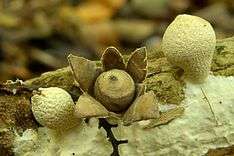Geastrum subiculosum
| Geastrum subiculosum | |
|---|---|
 | |
| Scientific classification | |
| Kingdom: | Fungi |
| Division: | Basidiomycota |
| Class: | Agaricomycetes |
| Order: | Geastrales |
| Family: | Geastraceae |
| Genus: | Geastrum |
| Species: | G. subiculosum |
| Binomial name | |
| Geastrum subiculosum Cooke & Massee (1887) | |
Geastrum subiculosum is an inedible species of fungus belonging to the genus Geastrum, or earthstar fungi. The fungus was first described scientifically by Cooke and Massee in 1887 (as Geaster subiculosus; Geaster is an older name for the genus Geastrum), based on material found near Trinity Bay, Australia. The fungus grows on decaying wood, and the fruit bodies are characterized by an extensive velvet-like subiculum (a crust-like growth of mycelium).[1] The spores are roughly spherical and measure 3.6–4.2 μm. The species is found in Australia, Africa (South Africa and the Congo), North America, and South America.[2]
References
- ↑ Cooke MC. (1887). "Some Australian fungi". Grevillea. 15 (76): 97–101.
- ↑ Dissing H, Lange M. (1962). "Gasteromycetes of Congo". Bulletin du Jardin botanique de l'État a Bruxelles. 32 (4): 325–416. JSTOR 3667249.
External links
This article is issued from
Wikipedia.
The text is licensed under Creative Commons - Attribution - Sharealike.
Additional terms may apply for the media files.